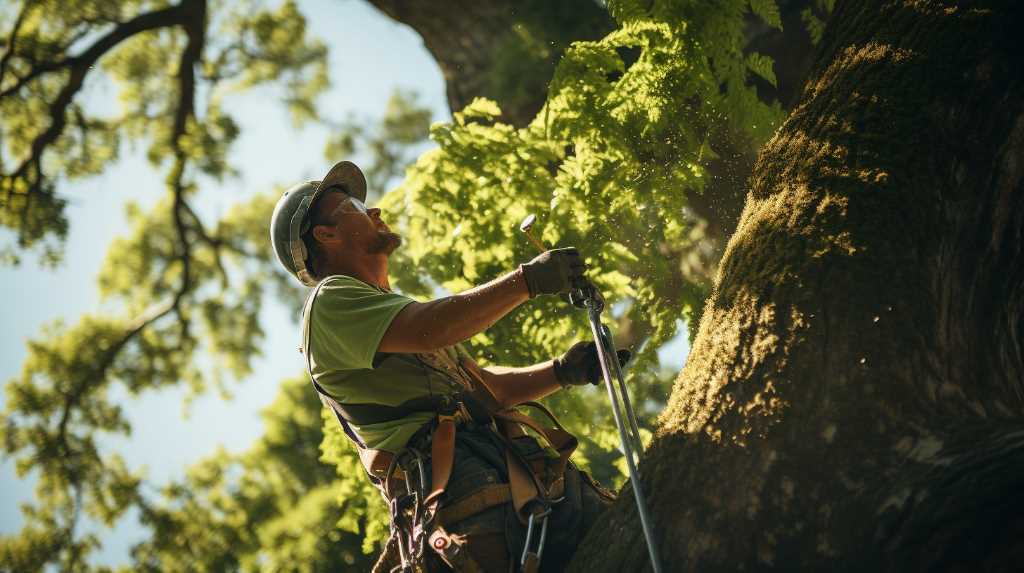Safety and Regulations
Expert Techniques for Professional Tree Pruning and Trimming

As an experienced arborist, I’ve discovered the secrets to achieving impeccable tree pruning and trimming results. Join me on this journey as I unveil expert techniques that will elevate your skills to new heights.
With proper timing, the right tools, and an understanding of tree growth patterns, you’ll learn how to master crown reduction and safely remove deadwood.
Get ready to become a part of the community of professional tree care enthusiasts who share a passion for the art of pruning and trimming.
Proper Timing for Pruning
I prefer to prune trees during their dormant period for optimal results. This period usually occurs in late winter to early spring, when the tree is in its dormant state and has shed its leaves. Pruning during this time allows the tree to focus its energy on healing and growth, without the added stress of producing leaves or flowers.
Additionally, pruning during the dormant period reduces the risk of disease transmission, as many pathogens are less active during this time. It’s important to note that not all trees have the same dormant period, so it’s crucial to research the specific tree species before pruning.
Selecting the Right Tools
To properly select the right tools for tree pruning and trimming, one must assess the specific needs and characteristics of the tree. Different trees require different tools for effective pruning and trimming.

For instance, small branches can be pruned using hand pruners or pruning shears, while larger branches may require a pruning saw or a chainsaw. It’s important to choose tools with sharp blades to ensure clean cuts and minimize damage to the tree. Additionally, tools with ergonomic handles provide comfort and reduce fatigue during long pruning sessions.
Understanding the specific needs of the tree, such as its size, growth pattern, and branch thickness, will help in selecting the most appropriate tools. Once the right tools are selected, one can proceed to understand the tree growth patterns and implement proper pruning techniques to promote healthy tree development.
Understanding Tree Growth Patterns
After selecting the right tools for tree pruning and trimming, it’s essential to understand the tree’s growth patterns to effectively promote healthy development. By understanding how trees grow, we can tailor our pruning and trimming techniques to maximize their potential. Here are some key points to consider:
- Branching structure: Different tree species have distinct branching patterns. Understanding these patterns can help us determine where to make cuts to encourage proper growth and minimize the risk of weak or hazardous branches.
- Apical dominance: Trees have a natural tendency to focus their growth on the main, central stem. By strategically pruning competing branches, we can redirect the tree’s energy towards the desired areas, promoting a more balanced and aesthetically pleasing shape.
- Seasonal growth patterns: Trees undergo growth spurts during specific times of the year. Recognizing these patterns allows us to time our pruning efforts for optimal results, ensuring minimal stress and quick recovery for the tree.
- Response to pruning: Different trees respond differently to pruning. Understanding how a particular species reacts to pruning cuts helps us determine the best techniques to use, promoting healthy regrowth and minimizing the risk of disease or decay.
Techniques for Crown Reduction
Understanding tree growth patterns is crucial for effective tree pruning and trimming. One important technique to consider is crown reduction.
Crown reduction is a pruning method used to reduce the overall size of a tree’s crown. This technique is often employed when a tree has grown too large for its surroundings or poses a risk to nearby structures or power lines.
Crown reduction involves selectively removing branches from the outer edges of the tree’s crown, resulting in a more compact and balanced shape. It’s important to note that crown reduction should be done carefully and in accordance with industry standards to avoid damaging the tree’s health and structure.
The process requires the use of proper pruning tools and techniques, such as making clean cuts at the branch collar and ensuring the tree’s overall health isn’t compromised.

Safely Removing Deadwood
When pruning and trimming trees, it’s important to regularly and safely remove deadwood. Deadwood can pose a significant risk to both people and property, making its removal a crucial part of tree maintenance. Here are some expert techniques for safely removing deadwood:
- Inspect the tree: Begin by visually inspecting the tree for dead branches and limbs. Look for signs of decay, such as discolored or brittle wood.
- Select the right tools: Use sharp bypass pruners or pruning saws to make clean cuts. Avoid using dull or rusty tools, as they can cause unnecessary damage to the tree.
- Make proper cuts: Cut back to a healthy branch collar or lateral bud to promote proper healing and reduce the risk of disease. Avoid leaving stubs or cutting too close to the trunk.
- Dispose of deadwood properly: Remove deadwood from the tree and dispose of it in a safe and environmentally friendly manner. This will help prevent the spread of pests and diseases.

Hello there! I’m Logan Foster, the green-thumbed social media marketer behind the vibrant world of 1800TreeGuy.com. With roots firmly planted in arboriculture, I’ve branched out to help clients cultivate their dream outdoor spaces, one leafy canopy at a time. My knack for nurturing nature is more than a profession—it’s a way of life.
When I’m not talking trees and teaching the art of arboreal care, you can find me cheering on the Bulldogs—my alma mater’s pride and my forever team. My environmental studies there didn’t just teach me about ecosystems; they instilled a lifelong passion for protecting our planet.
Off the clock, I’m an adventurer at heart. Whether it’s trekking the Appalachian trails, pedaling down a mountain path, or crafting guides to share the wonders of the wild, I’m happiest with soil under my nails and the sun on my face. And let’s not forget Yoda, my pug sidekick. He may not have mastered the art of stillness, but his joyful grins are my daily dose of happiness.
I’m all about making connections—between people and the great outdoors and between my clients and their ideal landscape visions. My approach is personal; every tree has a story, and every garden reflects its caretaker.
If you want to green your scene or share in my outdoor escapades, give me a shout on Instagram or Facebook. Let’s cultivate a conversation and grow a community rooted in a love for the lush life.







